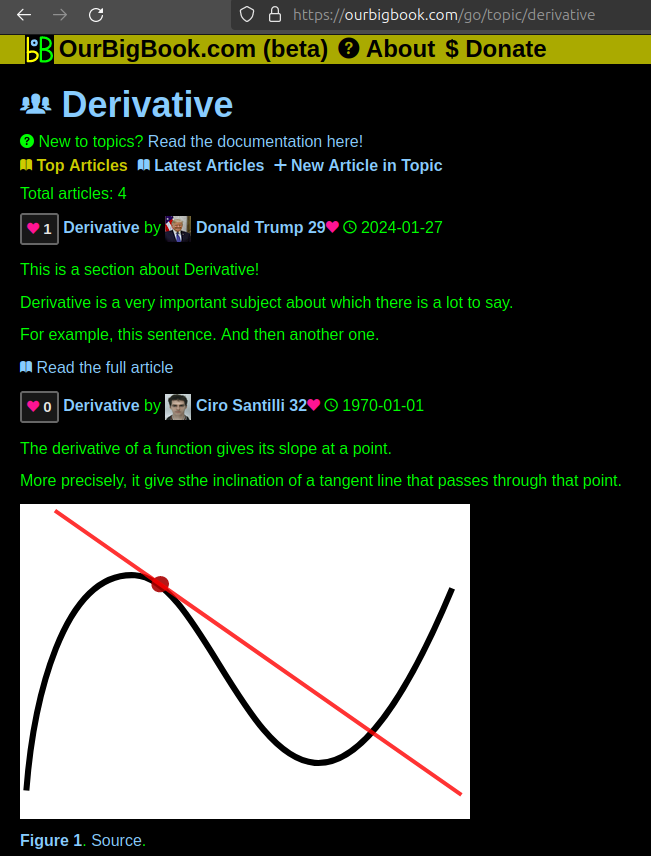As of 2019, the more formal name for particle physics, which is notably missing general relativity to achieve the theory of everything.
cds.cern.ch/record/799984/files/0401010.pdf The Making of the Standard Model by Steven Weinberg mentions three crucial elements that made up the standard model post earlier less generalized quantum electrodynamics understandings
Existence and uniqueness of solutions of partial differential equations by  Ciro Santilli 37 Updated 2025-07-16
Ciro Santilli 37 Updated 2025-07-16
Unlike for ordinary differential equations which have the Picard–Lindelöf theorem, the existence and uniqueness of solution is not well solved for PDEs.
For example, Navier-Stokes existence and smoothness was one of the Millennium Prize Problems.
The website is the reference instance of OurBigBook Web, which is part of the OurBigBook Project, the other main part of the project are software that users can run locally to publish their content such as the OurBigBook CLI.
The project documentation is present at: docs.ourbigbook.com#ourbigbook-web-user-manual
The topics feature allows you to find the best version of a subject written by other users user
. Live demo: derivative.OurBigBook's weird specialization towards the weird overly niche interests of its creator Ciro Santilli, notably "I want to create the perfect documentation for every atom in the universe, is undoubtedly partly to blame for the project's failure to gain even a single user outside of its own creator.
However, Ciro does also believe that innovation requires to some degree specializing weirdly in some niche direction. Success comes perhaps from both going into a novel and valuable direction, while still being anatomic enough for enough people.
The reason public relations is evil in modern society is because, like discrimination, public relations works by dumb association and not logic or fairness.
If you're the son of the killer, you're fucked.
This is unlike our ideal for law which attempts, though sometimes fails, at isolating cause and effect.
The degree of some algebraic structure is some parameter that describes the structure. There is no universal definition valid for all structures, it is a per structure type thing.
This is particularly useful when talking about structures with an infinite number of elements, but it is sometimes also used for finite structures.
Examples:
- the dihedral group of degree n acts on n elements, and has order 2n
- the parameter that characterizes the size of the general linear group is called the degree of that group, i.e. the dimension of the underlying matrices
The BSD conjecture states that if your name is long enough, it will always count as two letters on a famous conjecture.
Maybe also insert a joke about BSD Operating Systems if you're into that kind of stuff.
The conjecture states that Equation 1. "BSD conjecture" holds for every elliptic curve over the rational numbers (which is defined by its constants and )
Equation 1.
BSD conjecture
. Where the following numbers are defined for the elliptic curve we are currently considering, defined by its constants and :- : number of elements of the elliptic curve over the finite field, where the finite field comes from the reduction of an elliptic curve from to . can be calculated algorithmically with Schoof's algorithm in polynomial time
- : rank of the elliptic curve over the rational numbers. We don't really have a good general way to calculate this besides this conjecture (?).
- : a constant
The conjecture, if true, provides a (possibly inefficient) way to calculate the rank of an elliptic curve over the rational numbers, since we can calculate the number of elements of an elliptic curve over a finite field by Schoof's algorithm in polynomial time. So it is just a matter of calculating like that up to some point at which we are quite certain about .
The Wikipedia page of the this conecture is the perfect example of why it is not possible to teach natural sciences on Wikipedia. A million dollar problem, and the page is thoroughly incomprehensible unless you already know everything!
Written mostly by Eric W. Weisstein.
Ciro once saw a printed version of the CRC "concise" encyclopedia of mathematics. It is about 12 cm thick. Imagine if it wasn't concise!!!
Infinite Napkin is the one-person open source replacement we needed for it! And OurBigBook.com will be the final multi-person replacement.
If a product of a big company has a catchy name it came from an acquisition by  Ciro Santilli 37 Updated 2025-07-16
Ciro Santilli 37 Updated 2025-07-16
Bibliography:
- www.youtube.com/watch?v=j1PAxNKB_Zc Manifolds #6 - Tangent Space (Detail) by WHYB maths (2020). This is worth looking into.
- www.youtube.com/watch?v=oxB4aH8h5j4 actually gives a more concrete example. Basically, the vectors are defined by saying "we are doing the Directional derivative of any function along this direction".One thing to remember is that of course, the most convenient way to define a function and to specify a direction, is by using one of the coordinate charts.
- jakobschwichtenberg.com/lie-algebra-able-describe-group/ by Jakob Schwichtenberg
- math.stackexchange.com/questions/1388144/what-exactly-is-a-tangent-vector/2714944 What exactly is a tangent vector? on Stack Exchange
There are unlisted articles, also show them or only show them.


